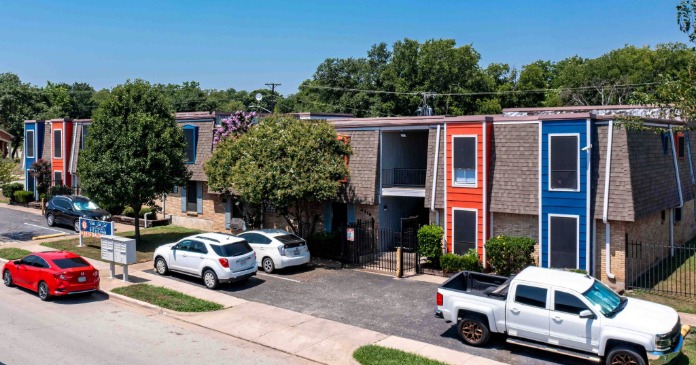Revisions to Fannie Mae’s housing forecast in March call for slightly more multifamily starts in 2025 but slightly fewer starts in 2026 than in last month’s forecast. Fannie Mae is now predicting 349,000 starts in 2025 with 379,000 starts in 2026.
The forecast for single-family housing starts was revised slightly lower in Q1 through Q3 of 2025 but slightly higher in every subsequent quarter through the end of 2026.
Lower growth but lower rates
Fannie Mae’s forecasters revised their predictions for GDP growth lower this month while revising their prediction for inflation higher. Despite the higher inflation forecast, Fannie Mae’s forecasters predicted that the Federal Reserve will lower the Fed Funds rate more deeply in 2026 than they predicted last month. While they still expect the Fed Funds rate to end 2025 at 4.1 percent, they now expect the Fed Funds rate to fall to 3.6 percent at the end of 2026. This is down from 4.1 percent in last month’s forecast.
Along with the lower forecast for the Fed Funds rate, this month’s forecast also predicts lower 10-year Treasury rates. The rate is predicted to fall to 4.3 percent in Q4 2025, down from a predicted rate of 4.7 percent in last month’s forecast. The rate is predicted to tick up to 4.4 percent at the end of 2026, but this is still lower than the 4.7 percent rate predicted for that date last month.
Multifamily starts forecast sees only modest changes
The current forecast for multifamily housing starts is shown in the first chart, below, along with three other recent forecasts. Fannie Mae considers any building containing more than one dwelling unit to be “multifamily”, including both condominiums and rental housing units.
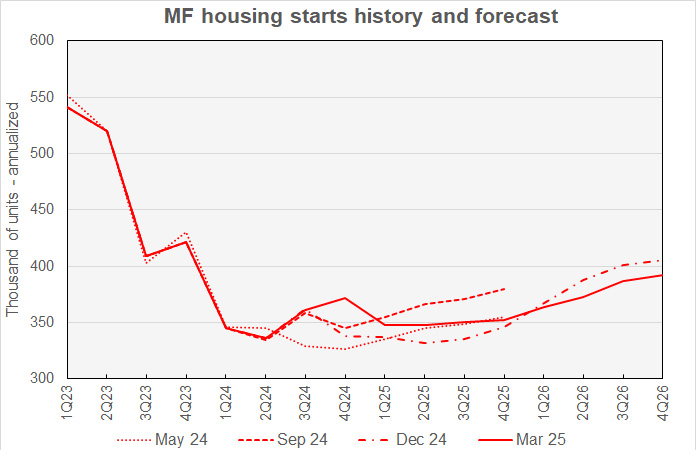
Revisions to Fannie Mae’s multifamily housing starts forecasts were mixed this month. The revisions to the quarterly forecasts for 2025 were all for 7,000 annualized units or less. The revisions to the quarterly forecasts for 2026 were larger late in the year, but none exceeded 16,000 annualized units.
The low point for multifamily starts is now seen as being in Q1 2025 with 348,000 annualized starts. The forecast calls for multifamily housing starts to rise from that point, ending with 392,000 annualized unit starts in Q4 2026. This is down from 408,000 annualized starts for Q4 2026 predicted last month.
For reference, the most recent new residential construction report from the Census Bureau has multifamily starts running at a seasonally-adjusted annualized rate of 374,000 units in Q4 2024.
Looking at yearly forecasts, the predicted number of multifamily starts for 2025 was revised higher by 3,000 units to 349,000 units. The forecast for multifamily starts in 2026 was revised lower by 11,000 units to 379,000 units.
Single-family starts forecast slightly lower
The current forecast for single-family housing starts is shown in the next chart, below, along with three other recent forecasts.
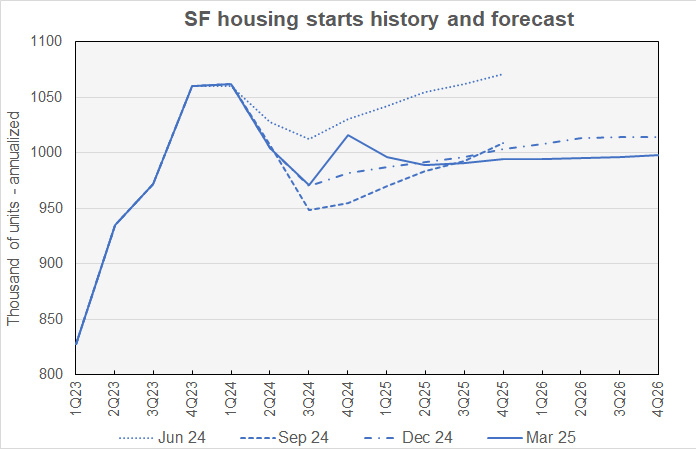
Revisions to the single-family starts quarterly forecasts were generally lower in the near term and higher in the long term than in last month’s forecast. The exception to this is that the starts “forecast” for Q4 2024 was revised higher by 13,000 units. It seems a little odd that the largest revision to a quarterly forecast was for a quarter that has already concluded, but that’s what the forecast numbers showed.
The low point for single-family starts going forward is now predicted to be Q3 2025 at 989,000 annualized units. Starts are forecast to rise from that point, but only very slowly. Single-family starts are predicted to reach an annualized rate of 998,000 in Q4 2026.
Looking at full-year predictions, Fannie Mae now expects 2,000 fewer single-family starts in 2025 than forecast last month at 993,000 units. Fannie Mae now expects 5,000 more single-family starts in 2026 than forecast last month at 996,000 units.
GDP growth for 2025 revised sharply lower
The next chart, below, shows Fannie Mae’s current forecast for Gross Domestic Product (GDP) growth, along with other recent forecasts.
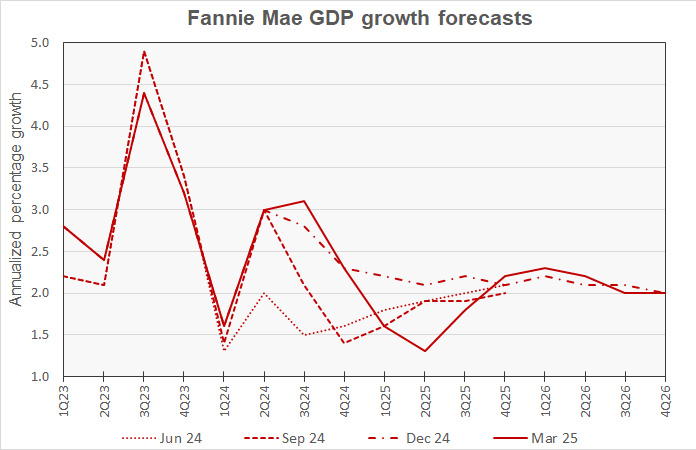
The Atlanta Fed made news when they revised their GDP Now Q1 2025 GDP growth estimate from +2.3 percent to -1.5 percent between their February 28 and March 3 releases. Fannie Mae’s forecasters have not revised their estimates for future GDP growth as dramatically, but they did revise their estimates for 2025 GDP growth lower in this month’s forecast. Growth estimates in Q1 and Q2 2025 were each revised lower by 0.9 percentage points to 1.6 percent and 1.3 percent respectively. Forecasted GDP growth was also revised lower for Q3 2025 and for Q3 and Q4 2026, but not so drastically. The only quarter to see an upward revision was Q4 2025, with a 0.1 percentage point uptick.
Fannie Mae’s forecasters now expect year-over-year GDP growth to be 1.7 percent in 2025 and 2.1 percent in 2026.
PCE Inflation forecast higher
The next chart, below, shows Fannie Mae’s current forecast for the chained personal consumption expenditures (PCE) inflation rate, along with three other recent forecasts.
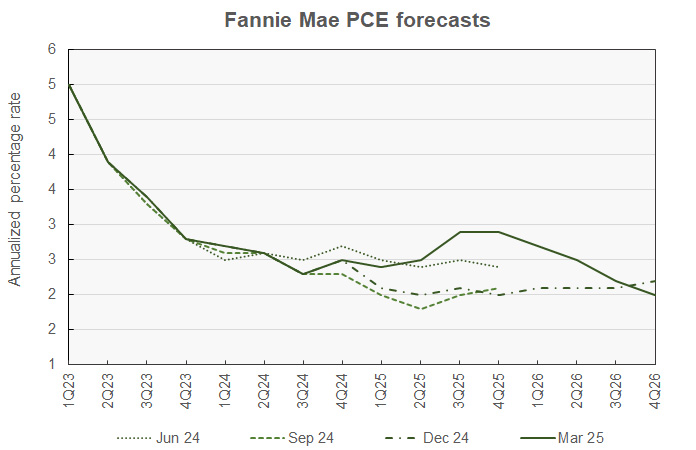
For the second consecutive forecast release, Fannie Mae’s forecasters raised their inflation forecasts for 2025 significantly. They expect inflation to climb through the year, peaking at 2.9 percent in both Q3 and Q4. The Q3 rate is up by 0.2 percentages points from last month’s estimate while the Q4 rate is 0.3 percentage points higher. However, the biggest boost was a 0.4 percentage point rise in the inflation estimate for Q1 2026. The increases reflect the one-time price increases that would result if President Trump makes good on his threats to impose higher tariffs on imports.
Fannie Mae now expects year-over-year PCE inflation of 2.9 percent in 2025, falling to 2.0 percent in 2026.
Employment growth lower in 2025
The next chart, below, shows Fannie Mae’s current forecast for employment growth, along with three earlier forecasts. Employment growth is our preferred employment metric since job gains, along with productivity gains, drive economic growth. By contrast, the unemployment rate depends on employment but also on the labor force participation rate. Either rising employment or falling labor force participation can drive the unemployment rate lower, but only the former would contribute to economic growth.
Note that the population estimates upon which the employment data is quoted was updated in January, so the figures from earlier forecasts may not be directly comparable to those from current forecasts.
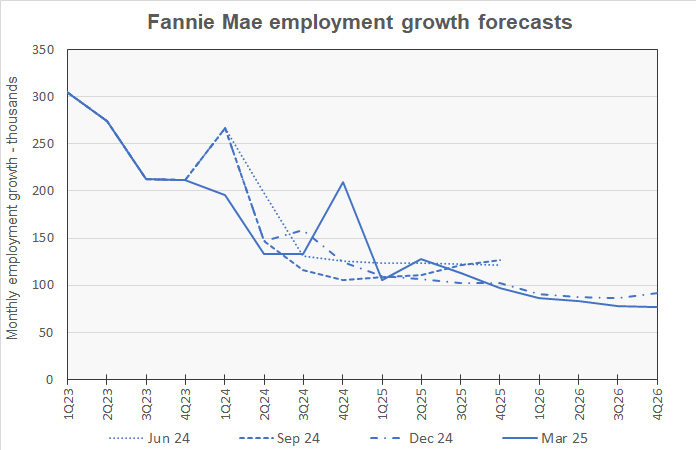
The forecasters revised their estimates for employment growth in 2025 lower by up to 62,000 jobs per month (Q1 2025). However, they revised their employment growth estimates modestly higher for 2026, although from low levels. After dipping to growth of 106,000 jobs per month in Q1 2025, employment growth is forecast to recover to 128,000 jobs per month in Q2. Employment growth is then predicted to fall quarter-by-quarter, reaching 77,000 jobs per month in Q4 2026.
For reference, the business survey in the March Employment Situation Report from the Bureau of Labor Statistics indicates that the economy added an average of 138,000 jobs per month through the first 2 months of Q1 2025.
Employment growth in 2025 is now expected to be 1,300,000 jobs, down by 400,000 jobs. The employment growth forecast for 2026 calls for the economy to add 1,000,000 jobs.
The Fannie Mae March forecast can be found here. There are links on that page to the detailed forecasts and to the monthly commentary.











